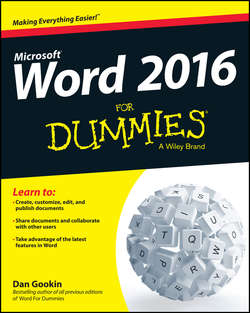Читать книгу Word 2016 For Dummies - Gookin Dan - Страница 7
Part I
Your Introduction to Word
Chapter 1
Hello, Word!
End Your Word-Processing Day
ОглавлениеIt's the pinnacle of etiquette to know when and how to excuse oneself. For example, the phrase “Well, I must be off,” works a lot better than growling, “Something more interesting must be happening anywhere else” – especially at Thanksgiving. The good news for Word is that’s completely acceptable to quit the program without hurting its feelings.
Quitting Word
When you've finished word processing and you don't expect to return to it anytime soon, you quit the Word program. Click the X button in the upper-right corner of the Word program window (refer to Figure 1-2).
The catch? You have to close each and every Word document window that’s open before you can proclaim that you’ve completely quit Word.
The other catch? Word won’t quit during that shameful circumstance when you have unsaved documents. If so, you’re prompted to save the document, as shown in Figure 1-4. My advice is to click the Save button to save your work; refer to Chapter 8 for specifics on saving documents.
Figure 1-4: Better click that Save button!
If you click the Don’t Save button, your work isn’t saved and Word quits. If you click the Cancel button, Word doesn’t quit and you can continue working.
✔ You don't have to quit Word just to start editing another document. Refer to the next couple of sections for helpful, timesaving information.
✔ After quitting Word, you can continue to use Windows by starting any other program, such as Spider Solitaire or perhaps something more relaxing, like Call of Duty.
Closing a document without quitting Word
You don't always have to quit Word. For example, if you're merely stopping work on one document to work on another, quitting Word is a waste of time. Instead, you can close the document.
To close a document in Word and not quit, follow these steps:
1. Click the File tab.
The File screen appears. Commands line the left side of the screen, as shown in Figure 1-5.
2. Choose the Close command.
3. Save the document, if you’re prompted to do so.
The shame! Always save before closing. Tsk-tsk.
Figure 1-5: The File tab screen.
After it’s closed, you return to the main Word window, although a document isn’t shown and many of the command buttons are dimmed (unavailable). At this point, you can start working on a new document or open a document you previously saved.
Bottom line: There’s no point in quitting Word when all you want to do is start editing a new document.
✔ There’s no urgency to close a document. I keep mine open all day, even when I go off to do something un-work related like play a game or see who’s being obnoxious on Facebook. To return to your document at any time, click its button on the Windows taskbar.
✔ The keyboard shortcut for the Close command is Ctrl+W. This command may seem weird, but it’s used to close documents in many programs.
✔ To swiftly start a new, blank document in Word, press Ctrl+N.
Setting Word aside
Don’t quit Word if you know that you will use it again soon. In fact, I've been known to keep Word open and running on my computer for weeks at a time. The secret is to use the Minimize button, found in the upper-right corner of the screen (refer to Figure 1-2).
Clicking the Minimize button shrinks the Word window to a button on the taskbar. With the Word window out of the way, you can do other things with your computer. Then when you're ready to word-process again, click the Word button on the taskbar to restore the Word window to the screen.
